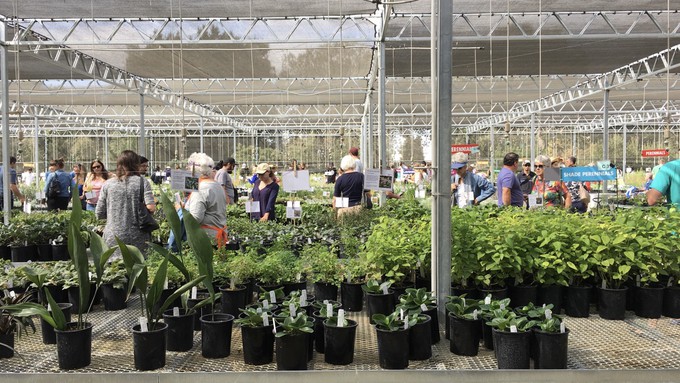
Hundreds of attractive, easy-care and water-wise plants will be available.

The plant shoppers return in person to the UC Davis Arboretum Teaching Nursery. (This photo is from a pre-pandemic sale.) Kathy Morrison
Thinking about adding some water-wise stars to your garden? It’s time to do some shopping.
With hundreds of drought-tolerant possibilities, UC Davis Arboretum’s Teaching Nursery hosts the first of three fall plant sales on Saturday, Oct. 1. As usual, this opening sale is reserved for members of Friends of the Arboretum.
Not a member yet? No problem. New members can join at the gate (or online) and receive an immediate 10% discount.
Sale hours are 9 a.m. to 1 p.m. Saturday. Closed to the public since last spring, the one-acre nursery is stuffed with plants including many Arboretum All-Stars, proven flowering plants that can thrive in Sacramento’s hot summers with less water. Also available are a wide range of attractive Mediterranean perennials and California natives. Find easy-care shrubs, trees, ground covers, bulbs and more – all suited to our climate and low-water landscapes. Most selections also benefit pollinators.
Before heading to the nursery, check out the selection online in the Arboretum’s Plant Sale Photo Gallery.
The first public sale is scheduled for 9 a.m. to 1 p.m. Oct. 22. (Friends members still get a 10% discount.) A clearance sale – the Arboretum’s final plant sale of 2022 – is set for 9 a.m. to 1 p.m. Nov. 5.
The Arboretum Teaching Nursery is located on campus on Garrod Drive near the small animal veterinary hospital.
For details, directions and the Plant Sale Photo Gallery: https://arboretum.ucdavis.edu.
– Debbie Arrington
Comments
0 comments have been posted.Sacramento Digs Gardening to your inbox.
Food in My Back Yard Series
May 6: Maintain soil moisture with mulch for garden success
April 29: What's (already) wrong with my tomato plants?
April 22: Should you stock up on fertilizer? (Yes!)
April 15: Grow culinary herbs in containers
April 8: When to plant summer vegetables
April 1: Don't be fooled by these garden myths
March 25: Fertilizer tips: How to 'feed' your vegetables for healthy growth
March 18: Time to give vegetable seedlings some more space
March 11: Ways to win the fight against weeds
March 4: Potatoes from the garden
Feb. 25: Plant a fruit tree now -- for later
Feb. 18: How to squeeze more food into less space
Feb. 11: When to plant? Consider staggering your transplants
Feb. 4: Starting in seed starting
Sites We Like
Garden Checklist for week of May 11
Make the most of the lower temperatures early in the week. We’ll be back in the 80s by Thursday.
* Plant, plant, plant! It’s prime planting season in the Sacramento area. Time to set out those tomato transplants along with peppers and eggplants. Pinch off any flowers on new transplants to make them concentrate on establishing roots instead of setting premature fruit.
* Direct-seed melons, cucumbers, summer squash, corn, radishes, pumpkins and annual herbs such as basil.
* Harvest cabbage, lettuce, peas and green onions.
* In the flower garden, direct-seed sunflowers, cosmos, salvia, zinnias, marigolds, celosia and asters. (You also can transplant seedlings for many of the same flowers.)
* Plant dahlia tubers.
* Transplant petunias, marigolds and perennial flowers such as astilbe, columbine, coneflowers, coreopsis, dahlias, rudbeckia and verbena.
* Keep an eye out for slugs, snails, earwigs and aphids that want to dine on tender new growth.
* Feed summer bloomers with a balanced fertilizer.
* For continued bloom, cut off spent flowers on roses as well as other flowering plants.
* Add mulch to the garden to maintain moisture. Mulch also cuts down on weeds. But don’t let it mound around the stems or trunks of trees or shrubs. Leave about a 6-inch-to-1-foot circle to avoid crown rot or other problems.
* Remember to weed! Pull those nasties before they set seed.
* Water early in the day and keep seedlings evenly moist.